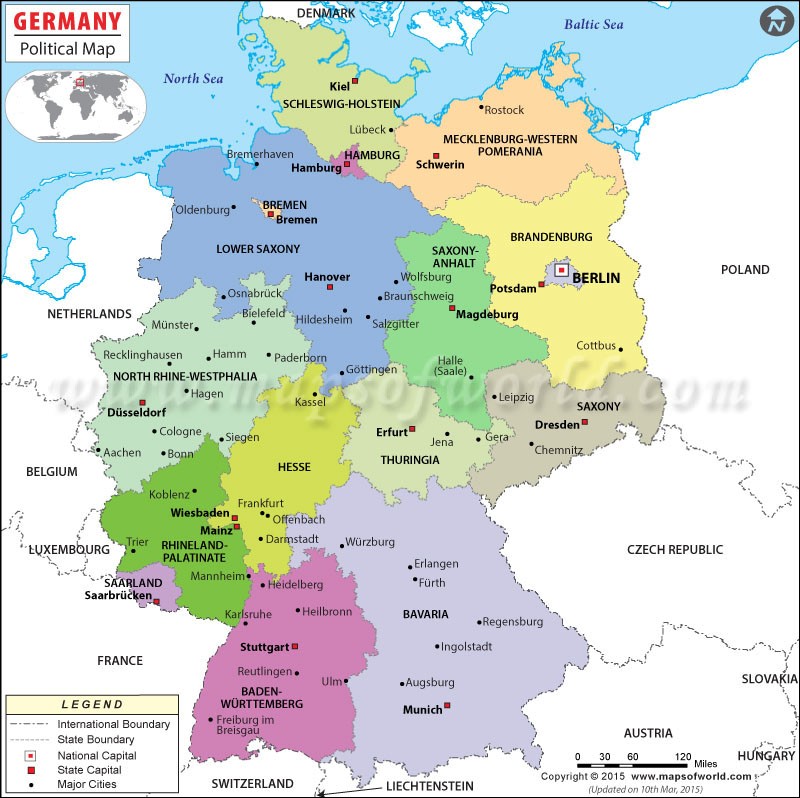Abstract
German federalism is one of the most unitary in the world. It started from assumptions based on the subsidiarity principle. They still are to be found in the German constitution. The lack of a federalism culture, the output orientation of German politics that stresses the sameness of living conditions, and party-political centralization have shaped Germany’s federalism. The last three reforms of German federalism 2006, 2009, and 2017 have all contributed to more centralism and shared decision-making of the federal government and the Land executives.
Introduction
From its very beginnings German federalism was devised as cooperative federalism based on federal-state interest intermediation. The German Constitution of 1949 over time was interpreted in a manner that allocates the lion’s share of legislative competences to the federal government (often as shared competences with the Länder). The Länder have most of the competences when it comes to the administration of law (including federal law). Consensus can be a choice, but it can also be the result of defeat. German federalism with the rare exception of the federalism reform of 2006 knows only one direction: more shared rule and less self-rule. This undermines the position of Land parliaments, though not necessarily of Land executives (governments). On the Land level, only a few competences and none without a certain federal role are left: the media, support for small and medium-sized enterprises, culture, police and education.
The German Constitution is built on the logic of the principle of subsidiarity. In Article 30, it starts from the assumption that the Länder are responsible for public policies and public administration, with the exceptions enumerated in the Constitution. In practical politics the Länder no longer dominate German statehood. Now the federal executive alone or in cooperation with the Länder executives sit in the driver’s seat. This is partly the case because the federal level has taken almost full control of the fields of concurrent legislation, and partly because the federal level has an almost exclusive right to make tax laws.

(Map of Germany)
In the post-war years, the cooperation of the federal level and the Länder still concentrated on problems to solve, such as the future of agriculture or economic support for the territories bordering the iron curtain disadvantaged by the partition of Germany (Zonenrandgebiete). Cooperation followed the principles of efficiency and financial viability. In the next few decades the federal level developed an appetite for a more systematic plan to bring Germany forward and together. This implied an improved steering capacity of central government for more and more policy fields. The additional impetus of German unification (1989/90) and the connected process of institution building led to even more strategic centralization. It was also the rationale behind financial transfers and the transfer of administrative and political personnel from West to East under the auspices of the federal government.
Cooperation became more than an occasional partnership. Cooperation was now hardened in an institutional network of joint decision-making. Cooperative federalism developed into “interlocking federalism”, into “Politikverflechtung” as the German political scientist Fritz W. Scharpf called the new phenomenon. For the general question, what is the right balance of diversity and unity in German federalism, new answers had to be found, because now it meant an evaluation of Länder autonomy in the light of interlocking federalism. The Länder were not opposed to the federalism reforms of the 1960s. For them, interlocking federalism implied budgetary stability. Their governments even gained political power via the Bundesrat, where the Länder executives supported the reforms of the Constitution with the necessary two-third majorities.
Explaining the Emergence of Unitary/ ‘Interlocking’ Federalism?
What are the driving forces behind a cooperative federalism that developed into a unitary federalism? Generally speaking, the lack of a culture of federalism. Germans see their federalism above all as a technical device to steer politics. If anything goes wrong in the political process, the solution is always more centralism. Champions of federalism would defend regional decision-making as an expression of vertical power-sharing, as an expression of regional autonomy. Germans seem to abhor territorial differences. This brings us to a second factor that explains the emergence of unitary federalism in Germany, the development of the welfare state. The welfare state has as its central promise the idea of equality. In Germany we witness the paradox that the public seems to believe that the most efficient federalism is not one that allows diversity, but one that guarantees equal treatment of everybody. This is, no doubt, a misleading interpretation of Article 20(1) of the German Constitution (Grundgesetz), which guarantees a social and federal state (“sozialer Bundesstaat”).
Party politics has supported this interpretation. For political parties social policies are vote winners. Parties offer uniform solutions for social problems in Germany. And parties are only to some extent federal organizations. Big decisions are made on the national level. These decisions include a role for regional party leaders, for example in coalitions talks on the national level or in joint meetings of the Land ministers or Land prime ministers. Party majorities in Land parliaments accept national decisions because the alternative would be to topple the party coalition in government on the Land level.
Via the Bundesrat (a quasi-second chamber of Parliament) the Länder executives have a formalized role in passing federal law. The Bundesrat has the potential to act as a chamber of the German Länder, and it sometimes does. But political coordination in the Bundesrat is based on party political cooperation. This cooperation has to overcome the challenge that decisions in the Bundesrat need an absolute majority of seats, which these days even so-called grand coalitions can no longer provide. It would be wrong to assume that the need to cooperate automatically creates harmony. It means more coordination, which strengthens the political executives on the federal and the Land level and weakens parliaments. Decisions are made by finding the smallest common denominator. This gives second best solutions a chance to succeed. Politics is slowed down, and fresh starts in politics are rare, but they are not impossible. Most of the time the result of federal-Land bargaining processes is a give and take. The Länder get federal financial support; and the federal level gets greater access to Länder responsibilities. The German fiscal constitution is another factor that provokes political centralization. The German Länder are notoriously underfunded, but they have only scant opportunities to raise taxes, about 95% of their expenditures are pre-determined by national and regional law. Since the balanced budget amendment to the Federal Constitution in 2009, they no longer have the right to borrow money. The only way out of a financial dilemma is support by the federal government. This support was always connected with a reduction of self-rule and an extension of shared rule, or the transfer of competencies from the regional to the national level.
The Relevance of Germany for Federalism Research
At first sight, German federalism seems to have two advantages. It seems to allow or even foster the economic success of a country, and it has a low level of regional conflicts. Where regional parties exist they are either given special treatment, like the party of the Danes and Frisians in Schleswig-Holstein which does not need to pass the five percent hurdle to make it in the Land parliament, or, as is the case for the Bavarian CSU, its role in national politics integrates support for regional interests into the political mainstream. It is difficult to prove, however, that Germany’s specific form of federalism has anything to do with the country’s economic success. The integration of regional interest articulation is very much facilitated by the absence of ethnic divisions in the country. The German example shows that there is a federalism scale on which German (and Austrian) federalism are close to one end of the scale, the unitary one bordering on no substantial federalism left.
What could be a success story in ethnically divided federal nations could be a Second Chamber along the lines of the Bundesrat to include regional elites in national decision-making to avoid secessionism, for example. What is also of interest for comparative studies is the fact that the number of different parties in regional coalition governments in Germany and the coalitions of different party-political composition has recently increased. Consensus-building in the Bundesrat, an institution with high hurdles for a political majority, deserves a fresh look. The stability assumption, which is so central for the marketing of German federalism, may come under threat. Still, for Germans the yard-stick for successful federalism remains its ability to deliver the promises of the welfare state, and the tool seems to be more centralism – although this contradicts the logic of federalism. Only some German lawyers and political scientists see this contradiction and favour diversity and the democratic potentials of decentralized government.
Suggested citation: Sturm, R. 2018. ‘Cooperative Federalism and the Dominant Role of Consensus in German Federalism’. 50 Shades of Federalism. Available at: http://50shadesoffederalism.com/case-studies/cooperative-federalism-dominant-role-consensus-german-federalism/
Further Reading
Julia Oberhofer/ Dieter Roth/ Julia Stehlin, Roland Sturm, Felix Wille: ‘Regional Citizenship in Germany: Solidarity and Participation in a Unitary Federal State’, in: Alisa Henderson/ Charlie Jeffery/ Daniel Wincott (eds): Citizenship after the Nation-State. Regionalism, Nationalism and Public Attitudes in Europe, Basingstoke: Palgrave 2014, S. 80-108.
Roland Sturm: ‘The Länder Lose out. Competence Sharing in German Federalism’, in: Ferdinand Karlhofer/ Günther Pallaver (eds.): Federal Power-Sharing in Europe, Baden-Baden: Nomos 2017, pp. 65-85.
Roland Sturm: ‘Counter-Secessionism and Autonomy in the Federal System of Germany: The Case of Bavaria’, in: Diego Muro/ Eckart Woertz (eds.): Secession and Counter-secession. An International Relations Perspective, Barcelona: CIDOB 2018, pp. 91-98.
Roland Sturm: ‘Unruly Divorces? Why Do Coalitions in the German Länder End Prematurely?’, in: Regional and Federal Studies 23(4), 2013, p. 445-460.

